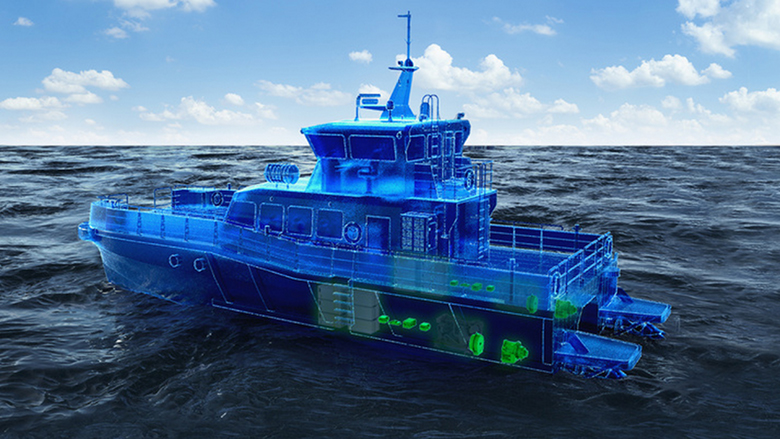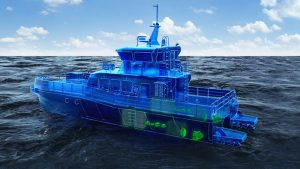
As transportation moves toward modern, eco-friendly solutions on land, maritime vessels are keeping up with the curve with a focus on developing economically and environmentally friendly solutions.
Several companies have recently announced innovations in fuel and propulsion systems on the market that will help marine vessels bridge the gap as they attempt to viably reach zero emissions.
In an effort to fight climate change, the International Maritime Organization in 2018 adopted an initial strategy related to reducing greenhouse gas emissions from ships, with a vision of phasing them out within the century.
The strategy aims to reduce the carbon intensity of international shipping by cutting CO2 emissions across the industry by at least 40% by 2030, and by 70% by 2050, as compared to 2008 emissions levels. They also are seeking to reduce total annual greenhouse gas emissions from international shipping by at least 50% by 2050 when compared to 2008.
Product/Technology: HybriGen Power and Propulsion; Builder: BAE Systems
As the industry is trending toward more modular and capable requirements, BAE Systems’ solution is next-generation hardware, said Eric Peterson, communications specialist for Power and Propulsion Solutions in the Electronic Systems sector.
BAE Systems recently launched the flexible HybriGen Power and Propulsion system, which uses smaller and lighter components for vessels and aims to help marine operators reach zero emissions.
Investing in this innovative technology can provide marine operators with cutting-edge capabilities to create clean transportation, said Steve Trichka, the vice president and general manager who oversees BAE’s power and propulsion efforts.
The company has developed electric propulsion systems for more than 25 years and BAE Systems’ electric propulsion technology supports low- and zero-emission applications with proven controls. Components are available in multiple system configurations.
The latest model improves electrical efficiency and vessel range, which increases propulsion power and simplifies installation.
Its modular accessory power system (MAPS) and modular power control system (MPCS) allow for a scalable, tailor-made solution to fit the specific power and propulsion requirements of a range of vessels, from sailboats and tugs to passenger ferries.
“Using a modular design, we can customize our solution to meet the exact needs of each customer, simplifying the installation and improving system reliability,” Trichka explained. “The increased propulsion power and electrical efficiency mean our customers can now accelerate their journey to zero emissions.”
Work on the HybriGen system is conducted at the company’s Endicott, N.Y. facility.
In announcing HybriGen’s launch, company officials noted that there are more than 14,000 power and propulsion systems from BAE Systems in markets across the globe.
“Each year, those systems contribute to a cleaner world by saving more than 30 million gallons of fuel and eliminating 335,000 tons of carbon dioxide each year—the equivalent of taking 59,000 cars off the road or planting 4.5 million trees,” the company said in a statement.
The hybrid technology started on land, in more than 12,000 transit buses around the world. Officials worked to bring the tech out onto the water to improve fuel savings and quiet, clean travel.
“Keeping waterways clean is important to our health and survival,” according to another company statement. “BAE Systems is helping provide sustainable water transport with our HybriGen power and propulsion solution. Our HybriGen system uses proven technology developed for the rugged transit duty cycle on land and takes it to the water.”
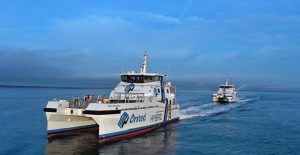
Product/Technology: Electric Hybrid Inboard Performance System; Builder: Volvo Penta
As the U.S. offshore wind farm market accelerates, Volvo Penta’s Inboard Performance System (IPS) is being chosen to power a growing number of offshore crew transfer vessels (CTVs), according to company spokesperson Emilie Depies.
The Virginia Pilots Association recently placed an order for its 10th Volvo Penta-powered pilot boat. That speaks to the success they’ve had with the product and support, Depies commented.
“In the North American market, we are continuing to see Volvo Penta as the propulsion system of choice for pilot boat associations,” Depies remarked.
The IPS propulsion system works well for CTVs as it features high-top speeds, slow-speed torque and superior grip, Depies said. This equates to great maneuverability and on-boat comfort. It also offers low emissions and efficient fuel economy at all speeds for savings in operating costs.
The company is taking IPS propulsion technology, revolutionary when it debuted in 2005, into a new phase—electric IPS. Volvo Penta recently partnered with Danfoss Editron to develop a unique electric hybrid propulsion system for a pair of new MHO-Co boats deployed in late 2021.
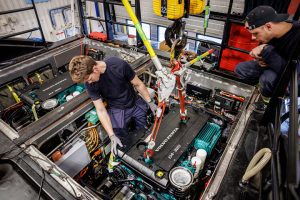
Volvo Penta Chief Technology Officer Peter Granqvist said the company strives for innovative and sustainable solutions to customer challenges.
“One of the best ways to advance our technology is to take on these bold projects and work collaboratively with other technology leaders,” Granqvist said. “This project is teaching us a lot about experimental technical solutions and we are excited to see the outcomes and learn more.”
The new hybrid system combines a Danfoss Editron electric drivetrain supported by variable speed gensets that drive two of the first integrated electric Volvo Penta IPS units, as well as two D13 Volvo Penta IPS units.
The two MHO-Co vessels made the 12,000 nautical-mile journey from the shipyard in China to MHO-Co’s headquarters in Denmark to service the Hornsea Project 2 offshore wind farm in the North Sea. The voyage was a trial at sea and provided some “lessons learned,” officials said, which helped them fine-tune the system for the vessel owner.
While in Denmark, batteries were installed to allow the vessels to operate in zero-emission electric mode at low speed and during long stationary periods. Or, in combination with diesel propulsion, to travel at a maximum speed of 24 knots.
Both CTVs are designed to be capable of operating in either fully electric or hybrid mode.
Officials were excited to see the vessels in action in the North Sea, Volvo Penta Sales Project Manager Jacob Vierø said.
“This pilot project has been hugely beneficial in helping us create the building blocks for future projects,” Vierø remarked. “Each operation will be different and require a tailor-made propulsion solution, but this project has allowed us to both develop the technology and collaborative process that can be adapted for future commercial operations.”
Product/Technology: SYDRIVE-M; Builder: Schottel
Propulsion systems manufacturer Schottel recently equipped several orders with its patented SYDRIVE-M system.
For light operation activities that don’t require full power, the new mechanical hybrid drive mechanically connects two mounted azimuth thrusters and one of the two main engines. This hybrid propulsion concept allows one of the two main engines to remain alternating off.
This leads to a noticeable reduction of operating hours of the main propulsion engines, and because the single running main engine operates in a better specific fuel consumption range, it results in lower maintenance costs, less fuel consumption and lower emissions.
When full propulsion power is needed for short operation times, the connection between the two thrusters is disengaged and each engine is engaged to each thruster.
For any directly driven vessel, the new SYDRIVE-M system also provides a solution to enable firefighting operation as the disengaged main engine is used to drive the FiFi-pump through its front PTO.
The new hybrid propulsion technology can make direct-driven vessels greener and more cost-efficient. No design changes are needed to integrate the SYDRIVE-M system into any standard vessel design with direct propulsion.
The company recently announced new projects in Brazil and Peru.
A newly built tug from PSA Marine Peru with Schottel RudderPropellers is to be outfitted with the mechanical hybrid solution and is expected to enter service in 2023.
William Revilla, a senior fleet manager with PSA Marine Peru, said the company is constantly on the lookout for sustainability-focused innovations.
“With reduced emissions, the forward-looking solution from Schottel allows us to operate our vessel more efficiently and sustainably,” Revilla said.
In South America, the Brazilian towage group Starnav is setting sails to reach the IMO’s 2030 goals.
Starnav is equipping four newly built tugs with Schottel RudderPropellers, one of which is to feature the SYDRIVE-M technology right from the start while the other three would be configured to be SYDRIVE-ready.
“By making use of Schottel hybrid solution, we are taking the initiative to increasingly seek a clean operation,” Starnav Serviços Marítimos CEO Carlos Eduardo Pereira said. “Starting now is particularly important: the vessels that are built today will be in the water for decades to come.”
Product/Technology: Twin D4-320 DPI Aquamatic Hybrid Engine; Builder: Volvo Penta
In an effort to find an unobtrusive solution for a sustainable tourism partner that works in frigid Arctic waters, Volvo Penta recently unveiled an advanced hybrid engine that can power a Norwegian sightseeing vessel quietly so guests can experience the wonders of nature without disturbing the habitat around them.
Hurtigruten Svalbard’s Kvitbjørn (which means ‘Polar Bear’ in English), a Marell M15 vessel, was formally launched in May 2021 and kicked off a three-year testing pilot program in the sub-zero temperatures around the Svalbard archipelago.
“This pilot project represents Volvo Penta’s commitment to sustainability targets and a big step in Volvo Penta’s electromobility journey at sea,” Depies said.
Extensive tests to simulate Svalbard’s icy conditions were performed by Volvo Penta engineers and project team leads before the vessel was delivered. This ensured it was ready for customer sea trials.
The vessel is powered by a Volvo Penta twin D4-320 DPI Aquamatic, which features hybrid diesel/electric propulsion. Volvo Penta and Marell Boats collaborated closely on the project, including the charging, ventilation, heating and air-conditioning systems.
It’s virtually silent in fully electric mode and the hydraulic clutch allows for smooth and soundless shifting at low engine speeds. It has a range of 500 nautical miles and is easily maneuverable, which is ideal for wildlife viewing. The functional stability of the system also provides ease when switching between driving modes.
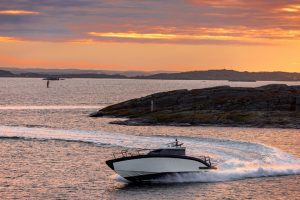
These features give it the potential to transform the sustainable tourism industry, Volvo Penta officials noted in a statement.
It’s one of the first times the company has taken a full-systems approach when developing a hybrid-electric solution. Another first? Designing a battery system able to operate at Arctic temperatures.
“This project was one of many firsts,” said project lead Mario Celegin. “The battery system is particularly interesting. Usually, these systems have to be cooled to between 20-30°C to operate safely and efficiently. But this vessel will be working in extreme temperatures—the average summer water temperature in Svalbard is around -2 to 0°C. To keep the battery temperatures at a steady 15°C, we’ve had to develop an integrated heating and cooling system that doesn’t circulate seawater to avoid icing.”
There was also a focus on sustainability. The new Volvo Penta power system allows for fully electric operation in the environmentally sensitive waters of Svalbard.
The company still focuses on fuel efficiency and marine torque, but is encouraged by increased interest in sustainable solutions on the market, Volvo Penta President of Marine Business Johan Inden said.
“We’re working to accelerate our sustainability solutions towards zero emissions,” Inden said.
“Our aim is to be the world leader in sustainable power solutions and to do this we want to partner with companies that have the vision and courage to join us,” added Volvo Penta Sales Project Manager Jonas Karnerfors.
The partnership with the Hurtigruten Group on the Kvitbjørn is a good example of this, Karnerfors said.
The two companies are also piloting a new business model, based on a “power-by-the-hour” payment program. This “e-mobility-as-a-service” model is still at the concept stage with further development possible down the line.
“This gives us the chance to learn how this model works in a real-world context, helping us to determine if this is a viable concept for the future,” Karnerfors said.

